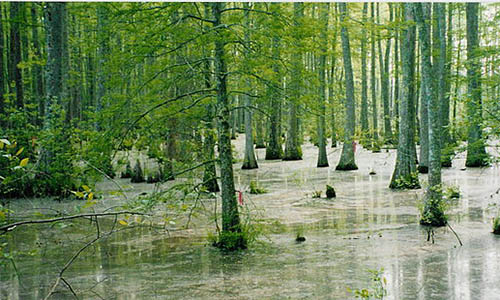Swamps are the wetlands which are seasonally submerged in the water. The land here might be completely under the water in some of the season and partially or fully above the water in some seasons. But the soil is always wet no matter what the season is. They can be found both in salt water and fresh water area.
Fact 1: The freshwater swamps between the Tigris and Euphrates Rivers in the Middle East are so rich in biodiversity that the area is called the “Fertile Crescent.” It is believed to be the birthplace of civilization and site of the first cities. The first written language and the invention of the wheel were done in this area.
Fact 2: The Everglades in Florida is called the “River of Grass”. This freshwater swamp is slow-moving River flowing from the Kissimmee River near Orlando to the Straits of Florida. It is 97 Kilometres wide and 160 kilometres long.
Fact 3: The salt water swamps are often called the “Nurseries of the Ocean” because the young of many marine animals find food and shelter in saltwater swamps. The young marine creatures get plenty of food and also protection here. Most of the marine creatures move to ocean from the swamps when they have grown up and come back here when they have to lay their eggs.
Fact 4: The two major types of swamps are “True Swamps” and “Transitional Swamps”. Like the name says True swamps are the swamps which are typical swamps where an entire forest is grown in a swamp land which is seasonally in and out of the water. The “Transitional Swamps” or “Shrub Swamps” are too wet to become a typical swamp. Mostly shrubs with very few trees grow in such areas.
Fact 5: It is believed t that Hurricane Katrina blew since the wetlands at the delta of the Mississippi River in Louisiana was drained as part of a massive system of river management. When Hurricane Katrina blew in from the Gulf of Mexico in 2005, the spongy swamp that traditionally protected the city of New Orleans from destructive weather patterns was diminished. The city was hit full force with a Category 3 hurricane.
Fact 6: Earlier Swamps were considered waste land since it could not be used for agriculture and it was not suitable for human stay. Also, since the land was a breeding ground for many insects and other organisms, people feared that such land caused diseases. People often drained them to make it suitable for living. But now few environmentalists have brought the fact to light, how important is it to conserve them in order to maintain balance in nature. As a result some of the countries have legally banned the draining of these lands.
Fact 7: The soil in the swamp is usually anaerobic, which means the Oxygen content in this soil is very less. Due to this reason, the plant and animal bodies in this soil doesn’t decompose and mix with soil. Whatever the organic wastes stuck in the soil will be trapped for years under the soil. When wooden pieces get stuck this way, they eventually turn into “Coal” after thousands of years.
Fact 8: The plants and animals growing in swamps are adapted to the fluctuating water levels here. Some of the animals like Frogs, Turtles, Crocodiles and Alligators are adapted to live in both water and land.
Fact 9: The anaerobic process in the swamps has given an idea for us in reusing the organic waste as fuel. This process is now used for processing the waste in many industries.
Fact 10: The largest swamp is found in the Amazon River basin.











December 6, 2016 2:41 pm
I like beer.
December 6, 2016 2:42 pm
Needs a pickle